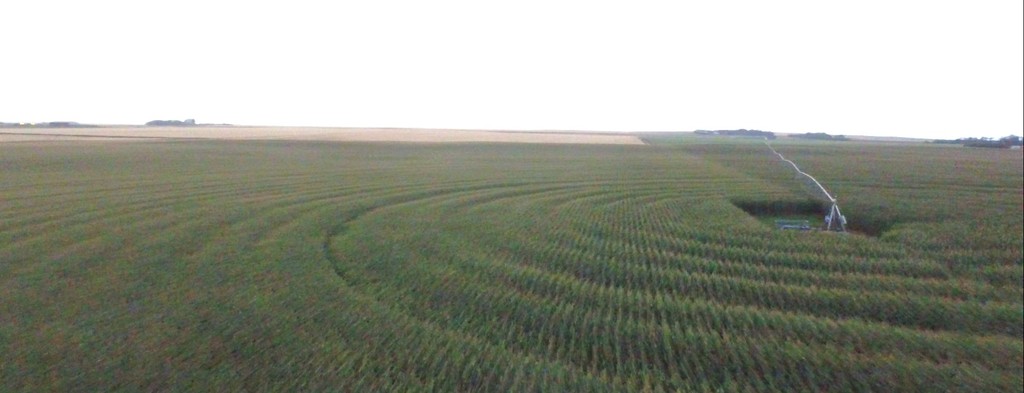Yield Loss Due to Correctable Irrigation Inefficiency
November 8, 2017

With advances in aerial technology and drones, farmers are now able to view their fields and crops in different ways. The above picture is just one example. The photo displays an irrigated quarter section of silage corn that was captured from drone footage.
As you can see, there are a number of ripples in the corn stand. These ripples were only present in the area covered by the first three pivot towers. The nozzles on the first three sections are spaced further apart than other sections of the pivot. The tall canopy of corn disrupts the even application of water from the wide-spaced, low hanging nozzles. This has ultimately led to an uneven application of water to the crop.
The uneven distribution of water resulted in a number of plants not reaching their maximum potential growth and thereby reducing the harvested yield of corn silage. Changes will need to be made to the nozzle package the next time corn is grown on this quarter section or on other prospective quarter sections that may have similar nozzle configuration. How much would this change be worth to a farmer? How would have yield been impacted by this change?
To calculate this, our consultants at Serecon first determined the amount of impacted area. This can be calculated as the difference in area between two differently sized circles. In our example, we estimated the size of the ripple to be three feet wide. Based on our observation of nine ripples per tower, the total impacted area within the first three towers totals 3.25 acres. We are assuming that the plants that appear taller in the first three towers have received sufficient water and were not restricted by the amount of water they received during the year. This simplifies our analysis to only measuring yield loss as a result of the ripples.
The next step is to determine the number of plants that are present in the impacted area. This field was seeded at 32,000 seeds per acre. An estimated survival rate of 95% was selected as an average for the field, therefore a total of 30,400 plants are growing in each acre, thereby resulting in a total of 98,915 plants impacted.
The last step to determining the amount of yield that was lost is to estimate the amount of weight per plant that was foregone by being under-watered. Corn that was under-watered was one foot shorter than the surrounding corn. The University of Wisconsin Extension Forage Research Team estimates that one foot of corn could total one ton of corn (30%) per acre. Based on our previous calculation, this works out to approximately 30 grams per plant at 30% moisture.
Typically, feedlots will adjust yield to account for differences in moisture. The standardized moisture level is 62.5% or 37.5% dry matter. In order to account for this, we need to adjust the grams per plant to account for this difference. After adjusting for moisture, the loss is estimated to be 37.5 grams per plant. We have developed the attached table to assess the impact varying per plant weight losses could have on total yield loss.
Based on the calculations, assumptions, and adjustments, the expected yield loss, would be approximately 3.96 tonnes. This is assuming that the loss per plant was approximately 40 grams per plant. In the case that the loss per plant were higher, the total yield loss could be significantly greater.
Improvements to the nozzle package on the pivot or changes in the nozzle spacing could eliminate this yield loss and provide greater revenue for the farmer.
To find out how Serecon can identify and correct deficiencies in your irrigation systems, email Todd Bergen-Henengouwen or call him at 780-540-5319